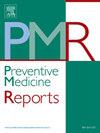The association of physical activity with perceived fatigability among community-dwelling older adults aged ≥60 years in regional China
IF 2.4
3区 医学
Q2 PUBLIC, ENVIRONMENTAL & OCCUPATIONAL HEALTH
引用次数: 0
Abstract
Objectives
This study aimed to investigate the association of physical activity with perceived fatigability among community-dwelling older adults in regional China.
Methods
Totally, 5484 community-dwelling residents aged 60+ years were randomly chosen from Nanjing municipality of China in this cross-sectional study in 2023. The outcome variable, perceived physical and mental fatigability, was assessed with the validated Chinese version of Pittsburgh Fatigability Scale. The independent variable, physical activity, was measured with the Chinese version of International Physical Activity Questionnaire. Mixed-effect logistic regression models were employed to compute odds ratios (ORs) and 95 % confidence intervals (95 %CIs) for examining associations of physical activity with both physical and mental fatigability.
Results
Among overall participants, the prevalence of physical and mental fatigability was 59.0 % (95CI = 57.7, 63.0) and 51.1 % (95 %CI = 49.8, 52.4), respectively. After adjustment for potential confounders, participants with sufficient physical activity were less likely to perceive either physical (OR = 0.66; 95 %CI = 0.55, 0.81) or mental (OR = 0.68; 95 %CI = 0.56, 0.83) fatigability compared to their counterparts with insufficient physical activity. Moreover, such negative associations of physical activity with physical and mental fatigability were observed for participants stratified by age/gender, with an exemption for the relationship between physical activity and physical fatigability in participants aged 80+ years.
Conclusions
Physical activity was negatively associated with either physical or mental fatigability for overall or age−/gender-specific community-dwelling residents aged 60+ years in regional China. This study has important implications for building healthy-aging societies, since it is possible to prevent or mitigate both physical and mental fatigability for older adults through population-level physical activity promotion.
中国地区≥60岁社区居住老年人体力活动与感知疲劳的关系
目的本研究旨在调查中国地区社区居住老年人体力活动与感知疲劳的关系。方法于2023年在南京市随机抽取5484名60岁以上的社区居民进行横断面研究。结果变量感知身心疲劳程度采用经验证的中文版匹兹堡疲劳量表进行评估。自变量体力活动采用中文版《国际体力活动问卷》进行测量。采用混合效应逻辑回归模型来计算比值比(ORs)和95%置信区间(95% ci),以检验体力活动与身心疲劳的关系。结果在所有参与者中,身体和精神疲劳的患病率分别为59.0% (95% CI = 57.7, 63.0)和51.1% (95% CI = 49.8, 52.4)。在对潜在的混杂因素进行调整后,体力活动充足的参与者不太可能感知到身体(OR = 0.66;95% CI = 0.55, 0.81)或心理(or = 0.68;95% CI = 0.56, 0.83)的疲劳程度。此外,在按年龄/性别分层的参与者中,观察到身体活动与身心疲劳的负相关,而在80岁以上的参与者中,身体活动与身体疲劳的关系则不存在。结论中国地区60岁以上社区居民总体或年龄/性别不同,体力活动与身心疲劳呈负相关。这项研究对建立健康老龄化社会具有重要意义,因为有可能通过促进人口水平的体育活动来预防或减轻老年人的身心疲劳。
本文章由计算机程序翻译,如有差异,请以英文原文为准。
求助全文
约1分钟内获得全文
求助全文
来源期刊

Preventive Medicine Reports
Medicine-Public Health, Environmental and Occupational Health
CiteScore
3.90
自引率
0.00%
发文量
353
 求助内容:
求助内容: 应助结果提醒方式:
应助结果提醒方式:


